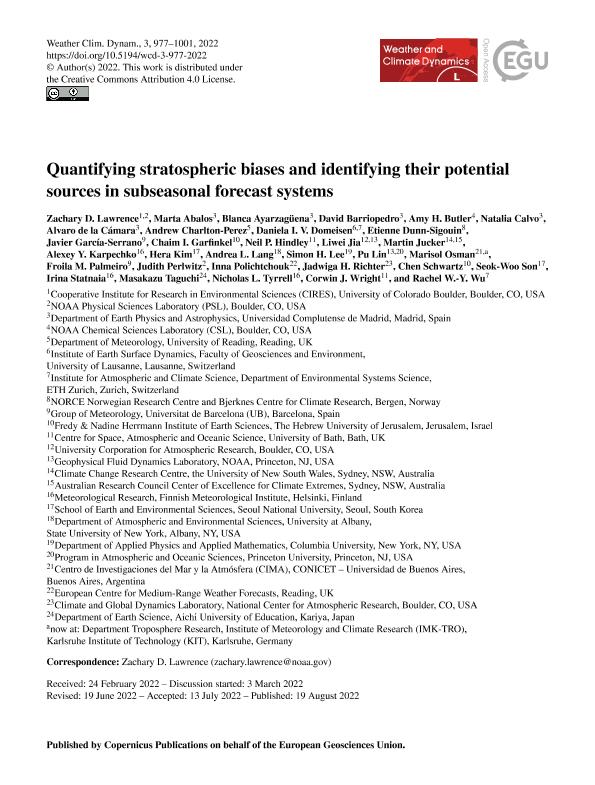Artículo
Quantifying stratospheric biases and identifying their potential sources in subseasonal forecast systems
Lawrence, Zachary D.; Abalos, Marta; Ayarzagüena, Blanca; Barriopedro, David; Butler, Amy H.; Calvo, Natalia; de la Cámara, Alvaro; Charlton-Perez, Andrew; Domeisen, Daniela I.V.; Dunn Sigouin, Etienne; García Serrano, Javier; Garfinkel, Chaim I.; Hindley, Neil P.; Jia, Liwei; Jucker, Martin; Karpechko, Alexey Y.; Kim, Hera; Lang, Andrea L.; Lee, Simon H.; Lin, Pu; Osman, Marisol ; Palmeiro, Froila M.; Perlwitz, Judith; Polichtchouk, Inna; Richter, Jadwiga H.; Schwartz, Chen; Son, Seok Woo; Statnaia, Irina; Taguchi, Masakazu; Tyrrell, Nicholas L.; Wright, Corwin J.; Wu, Rachel W.-Y.
; Palmeiro, Froila M.; Perlwitz, Judith; Polichtchouk, Inna; Richter, Jadwiga H.; Schwartz, Chen; Son, Seok Woo; Statnaia, Irina; Taguchi, Masakazu; Tyrrell, Nicholas L.; Wright, Corwin J.; Wu, Rachel W.-Y.
 ; Palmeiro, Froila M.; Perlwitz, Judith; Polichtchouk, Inna; Richter, Jadwiga H.; Schwartz, Chen; Son, Seok Woo; Statnaia, Irina; Taguchi, Masakazu; Tyrrell, Nicholas L.; Wright, Corwin J.; Wu, Rachel W.-Y.
; Palmeiro, Froila M.; Perlwitz, Judith; Polichtchouk, Inna; Richter, Jadwiga H.; Schwartz, Chen; Son, Seok Woo; Statnaia, Irina; Taguchi, Masakazu; Tyrrell, Nicholas L.; Wright, Corwin J.; Wu, Rachel W.-Y.
Fecha de publicación:
08/2022
Editorial:
Copernicus Publications
Revista:
Weather and Climate Dynamics
e-ISSN:
2698-4016
Idioma:
Inglés
Tipo de recurso:
Artículo publicado
Clasificación temática:
Resumen
The stratosphere can be a source of predictability for surface weather on timescales of several weeks to months. However, the potential predictive skill gained from stratospheric variability can be limited by biases in the representation of stratospheric processes and the coupling of the stratosphere with surface climate in forecast systems. This study provides a first systematic identification of model biases in the stratosphere across a wide range of subseasonal forecast systems. It is found that many of the forecast systems considered exhibit warm global-mean temperature biases from the lower to middle stratosphere, too strong/cold wintertime polar vortices, and too cold extratropical upper-troposphere/lower-stratosphere regions. Furthermore, tropical stratospheric anomalies associated with the Quasi-Biennial Oscillation tend to decay toward each system’s climatology with lead time. In the Northern Hemisphere (NH), most systems do not capture the seasonal cycle of extreme-vortex-event probabilities, with an underestimation of sudden stratospheric warming events and an overestimation of strong vortex events in January. In the Southern Hemisphere (SH), springtime interannual variability in the polar vortex is generally underestimated, but the timing of the final breakdown of the polar vortex often happens too early in many of the prediction systems. These stratospheric biases tend to be considerably worse in systems with lower model lid heights. In both hemispheres, most systems with low-top atmospheric models also consistently underestimate the upward wave driving that affects the strength of the stratospheric polar vortex. We expect that the biases identified here will help guide model development for subseasonal-to-seasonal forecast systems and further our understanding of the role of the stratosphere in predictive skill in the troposphere.
Palabras clave:
Sudden Stratospheric Warming
,
Eddy-driven Jet
Archivos asociados
Licencia
Identificadores
Colecciones
Articulos(CIMA)
Articulos de CENTRO DE INVESTIGACIONES DEL MAR Y LA ATMOSFERA
Articulos de CENTRO DE INVESTIGACIONES DEL MAR Y LA ATMOSFERA
Citación
Lawrence, Zachary D.; Abalos, Marta; Ayarzagüena, Blanca; Barriopedro, David; Butler, Amy H.; et al.; Quantifying stratospheric biases and identifying their potential sources in subseasonal forecast systems; Copernicus Publications; Weather and Climate Dynamics; 3; 3; 8-2022; 977-1001
Compartir
Altmétricas



